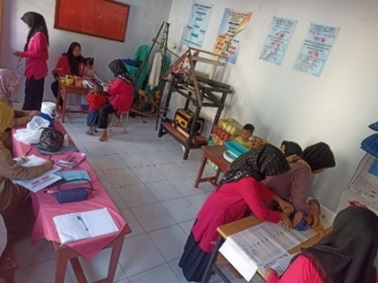Pendampingan Masyarakat Mengenai Pemanfaatan Tanaman TOGA sebagai Pemenuhan Gizi di Kecamatan Kawali Kabupaten Ciamis Community Assistance Regarding the Use of TOGA Plants to Fulfill Nutrition in Kawali District Ciamis Regency
Main Article Content
Abstract
Fulfilling nutritional intake can be done by utilizing TOGA plants. TOGA plants have high nutritional content to support the fulfillment of daily nutritional needs. The aim of community service related to TOGA plants is to increase community understanding and access to nutritional sources needed to prevent high levels of malnutrition. The method used is Participatory Action and Learning and evaluated using pre-test and post-test methods. There was an increase in knowledge scores at the end of the training, namely an average of 15.8 points. The variation in knowledge scores on the pre-test tends to be higher than on the post-test, this shows that there is a similar perception of understanding of the material at the end of the training.
Downloads
Article Details

This work is licensed under a Creative Commons Attribution-ShareAlike 4.0 International License.
Authors who publish with this journal agree to the following terms:
- Any article on the copyright is retained by the author(s).
- Author grant the journal, right of first publication with the work simultaneously licensed under a Creative Commons Attribution License that allows others to share work with acknowledgment of the work authors and initial publications in this journal.
- Authors are able to enter into a separate, additional contractual arrangements for non-exclusive distribution of published articles of work (eg, post-institutional repository) or publish it in a book, with acknowledgment of its initial publication in this journal.
- Authors are permitted and encouraged to post their work online (e.g., in institutional repositories or on their websites) prior to and during the submission process, as can lead to productive exchanges, as well as earlier and greater citation of published work.
- The article and any associated published material is distributed under the Creative Commons Attribution-ShareAlike 4.0 International License
References
Alam, R. (2019). Comparative Analysis Between Pre-test/Post-test Model and Post-test-only Model in Achieving the Learning Outcomes. Pakistan Journal of Ophthalmology, 35. https://doi.org/10.36351/pjo.v35i1.855
Bardosono, S. (2017). The Importance of Nutrition Journal Publication. World Nutrition Journal, 1. https://doi.org/10.25220/WNJ.V01i1.0001
Ciamis, B. (2020). Percepatan Pencegahan Stunting Terintegrasi di Kabupaten Ciamis. Peraturan Bupati Ciamis, 38.
de Onis, M., & Branca, F. (2016). Childhood stunting: a global perspective. Maternal & Child Nutrition, 12(S1), 12-26. https://doi.org/10.1111/mcn.12231
Dimitrov, D., & Rumrill, P. (2003). Pretest-Posttest Designs and Measurement of Change. Work (Reading, Mass), 20, 159-165.
Erma Widiana, M., Wahyudi, S., Shofwan, M., & Enny Widyaningrum, M. (2022). Inovasi Snack Bergizi Tanaman Toga dalam Peningkatan Ekonomi Masa New Normal. Sewagati, 6(5). https://doi.org/10.12962/j26139960.v6i5.41
Kardila, M., Hadhikul, M., Aulia, V., & Wardani, L. K. (2023). Risks of Stunting and Interventions to prevent Stunting. Journal of Community Engagement in Health, 6(2), 79-83. https://doi.org/10.30994/jceh.v6i2.528
Kesehatan, B. K. P. (2022). Buku Saku Hasil Studi Status Gizi Indonesia (SSGI) Tahun 2022. K. K. R. Indonesia.
Mindarti, S., & Nurbaeti, B. (2015). Buku Saku Tanaman Obat Keluarga (TOGA). Balai PengkajianTeknologi Pertanian Jawa Barat.
Nugraha, S. P. (2015). Pelatihan penanaman tanaman obat keluarga (TOGA). AJIE (Asian Journal of Innovation and Entrepreneurship), 4(01), 58-62.
Patola, E., & Martana. (2018). Pelatihan dan Pendampingan Budidaya Tanaman Obat Keluarga Di Pekarangan. Adi Widya : Jurnal Pengabdian Masyarakat, 2(2). https://doi.org/10.33061/awpm.v2i2.2522
Perpres. (2020). Peraturan Presiden Nomor 18 Tahun 2020 tentang Rencana Pembangunan Jangka Menengah Nasional Tahun 2020-2024. J. P. R. Indonesia.
Wood, L. (2019). Participatory action learning and action research: Theory, practice and process. Routledge.
